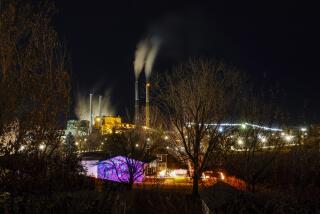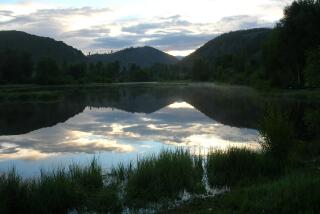A steam-powered train trip into West Virginia’s past

Reporting from Cass, W. Va. — At the old mill town of Cass, nestled deep in a remote holler of West Virginia, coal smoke and history hang in the air.
The smoke is from the geared steam locomotives that serve the Cass Scenic Railroad. Ideal for steep grades and marginal track, these Shays — named for Ephraim Shay, who designed the eccentric but effective locomotives — once toted logs from the woods to the lumber mill at Cass. Today, they haul visitors by the thousands up into those same woods.
And the history? It concerns the lumbering industry that once thrived in the region and the unique, no-nonsense railways that served it.
“Cass is West Virginia’s Williamsburg,” says Gerri Bartels, an interpreter at Cass Scenic Railroad State Park. “And it’s not just about the train.” Though I agreed with Bartels as we shared a walking tour of this white-clapboard company town, I knew that most in the group would not be here but for the train ride that is the park’s centerpiece.
West Virginia park officials thought this way too. The state bought the railroad from the Mower Lumber Co. shortly after it shuttered operations in 1960. In 1978, the town was added to the park in belated recognition of its importance to lumbering and its culture. The town’s population peaked in 1923, when it numbered more than 2,000; today it has dwindled to a handful of residents.
Other than loggers going to work, passengers were not the business of the Mower Lumber Co. or of West Virginia Pulp & Paper, its predecessor. Thus, the passenger cars used by the Cass Scenic Railroad are rudimentary, although most are roofed, because the weather at the high elevations to which the line ascends can be changeable. They are not historic, but the eight potentially serviceable locomotives surely are. Shay No. 5 has plied the same line since 1905. No. 6, the last Shay built and one of the largest, also worked in West Virginia, as did three other Cass locomotives. Others have been collected from as far away as California and British Columbia.
Matching the locomotives’ historicity are Cass’ buildings, but with some compromises forced by fire. Though typical of the stations of the Chesapeake & Ohio Railway, the main-line railroad that served Cass, the handsome depot from which Cass trains now depart is a replica built in 1975, after the 1923 building burned. The locomotive shops, built at the same time as the depot, burned in 1972 and have been replaced.
Looming behind the depot is the original general store, the Pocahontas Supply Co., built in 1902. Today it sells souvenirs instead of the modest necessities of life for loggers, mill employees and their families. A few of the houses for company officers, superintendents and foremen are in an area dubbed Big Bug Hill and are now occupied by locals, as are some of the cookie-cutter clapboard company houses. Visitors can rent any one of 20 of these three-, four- and five-bedroom houses, handsomely refurbished, by the day or week at modest rates.
At the depot, you can board a train for the two-hour round trip to Whittaker Station, a little less than four miles away, or for one of two longer runs to Spruce (where a once-bustling mill town has vanished) or to Bald Knob, 11 miles away and, at 4,842 feet, one of the highest points in West Virginia. This is where logging by the Mower Lumber Co. petered out in 1960, and the views from there are spectacular.
I’ve visited Cass twice on Railfan Weekend, including last month, just before its regular season began. On the Saturday of my earlier visit, I headed for Spruce, with Shay No 5 announcing its departure with two blasts of its lovely chime whistle. We rolled by the twisted, rusted remnants of a sawmill, a relic that tugged at me as castle ruins in Europe do. We passed the shops and before long crossed Leatherbark Creek and were into the stiff grade that showed why geared locomotives have always been essential to railroading at Cass.
In 1874, Shay, a former doctor who loved things mechanical, built his first locomotive. Six years later, he sold the construction rights to Lima Machine Works, which provided Shays for virtually every logging railroad in the country. Two similar designs — the Heisler and the Climax (and Cass has examples of both) — provided competition, but not much. With their small wheels and articulation, these geared locomotives could waddle sure-footedly over improvised, ungraded track, around tight curves and up hills that traditional rigid-frame steam locomotives with large driving wheels couldn’t begin to tackle. Shays are not fleet of foot, despite the frantic flailing of their vertical pistons, but they are powerful.
Up Cass Hill we climbed, with No. 5 and sister Shay No. 2 churning furiously to conquer sustained grades in excess of 6% (6 feet up per 100 feet forward) that flirt with 9% for short stretches. (With conventional locomotives, steam or diesel, about 3% is considered the limit, and a taxing one.) But even with these steep gradients, scaling the mountain required two switchbacks, or zigzags, the rarest of all railway engineering expedients and a cumbersome last resort in gaining elevation. After the upper switchback, it was just half a mile to Whittaker Station, the site of the Mountain State Railroad & Logging Historical Assn.’s re-created 1940s logging camp.
There are three shanties, including one for the saw filer, who was responsible for keeping tools sharp, and one for the surveyor, or “cruiser,” who decided which trees to cut and how to get the logs to the railhead. The Lidgerwood Skidder on display transported logs to the railroad siding.
Steaming on, in about five miles we were at Spruce, in a broad, high valley on Shaver’s Fork of the Cheat River. This mill town, established in 1902 by West Virginia Pulp & Paper, featured a two-story hotel with 30 rooms, electric lights, hot running water and steam heat. There were company houses much like those at Cass, a pulp mill, a locomotive shop, company offices and elaborate homes for officials.
Today, only a few fragments of concrete foundation and scraps of metal remain, barely visible as the eye scans the lovely valley. That Spruce has so thoroughly vanished makes the intact town of Cass all the more precious.
“It’s like Brigadoon,” Bartels says of Spruce, “but it’s not coming back in 100 years.”
More to Read
Sign up for The Wild
We’ll help you find the best places to hike, bike and run, as well as the perfect silent spots for meditation and yoga.
You may occasionally receive promotional content from the Los Angeles Times.






